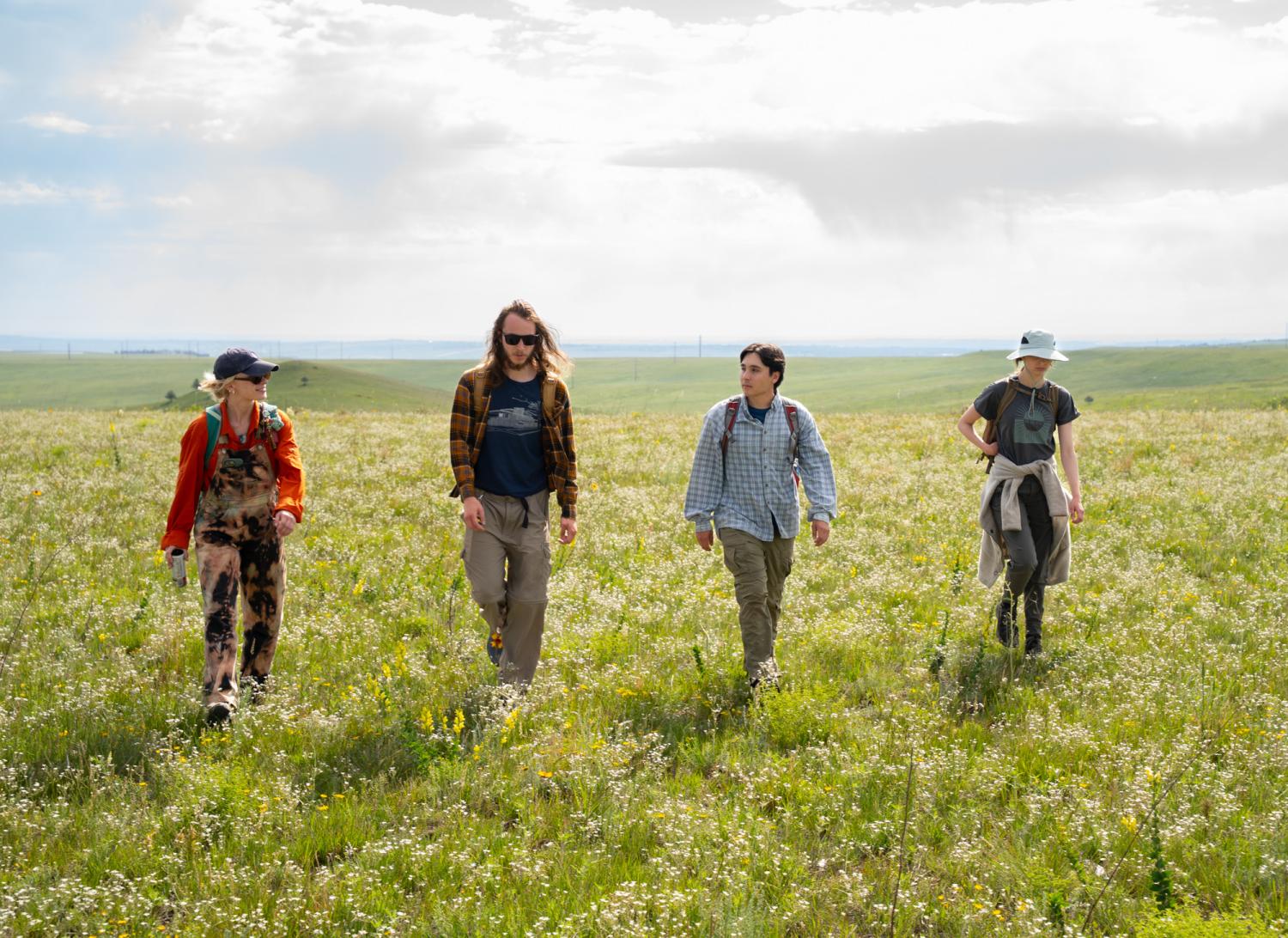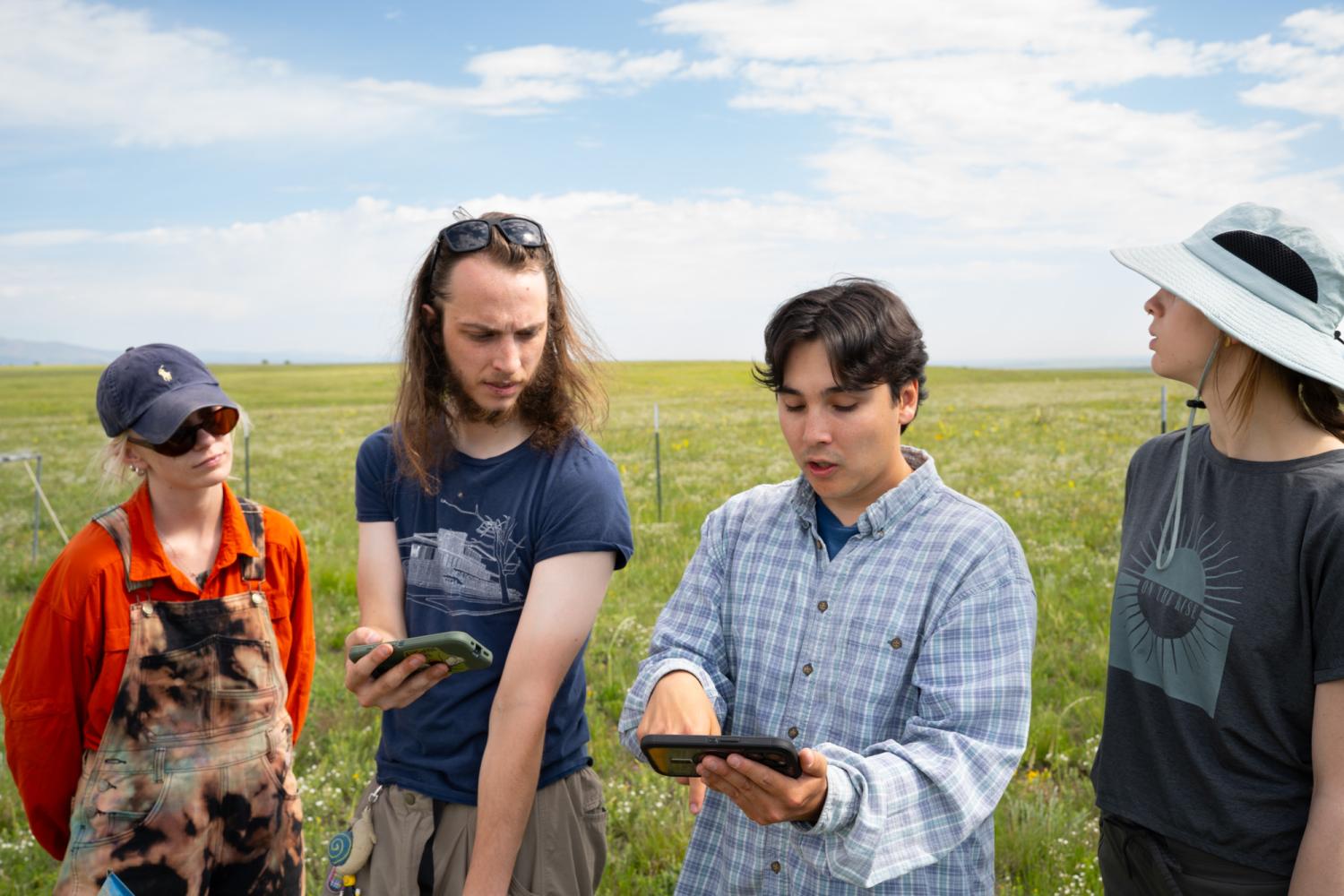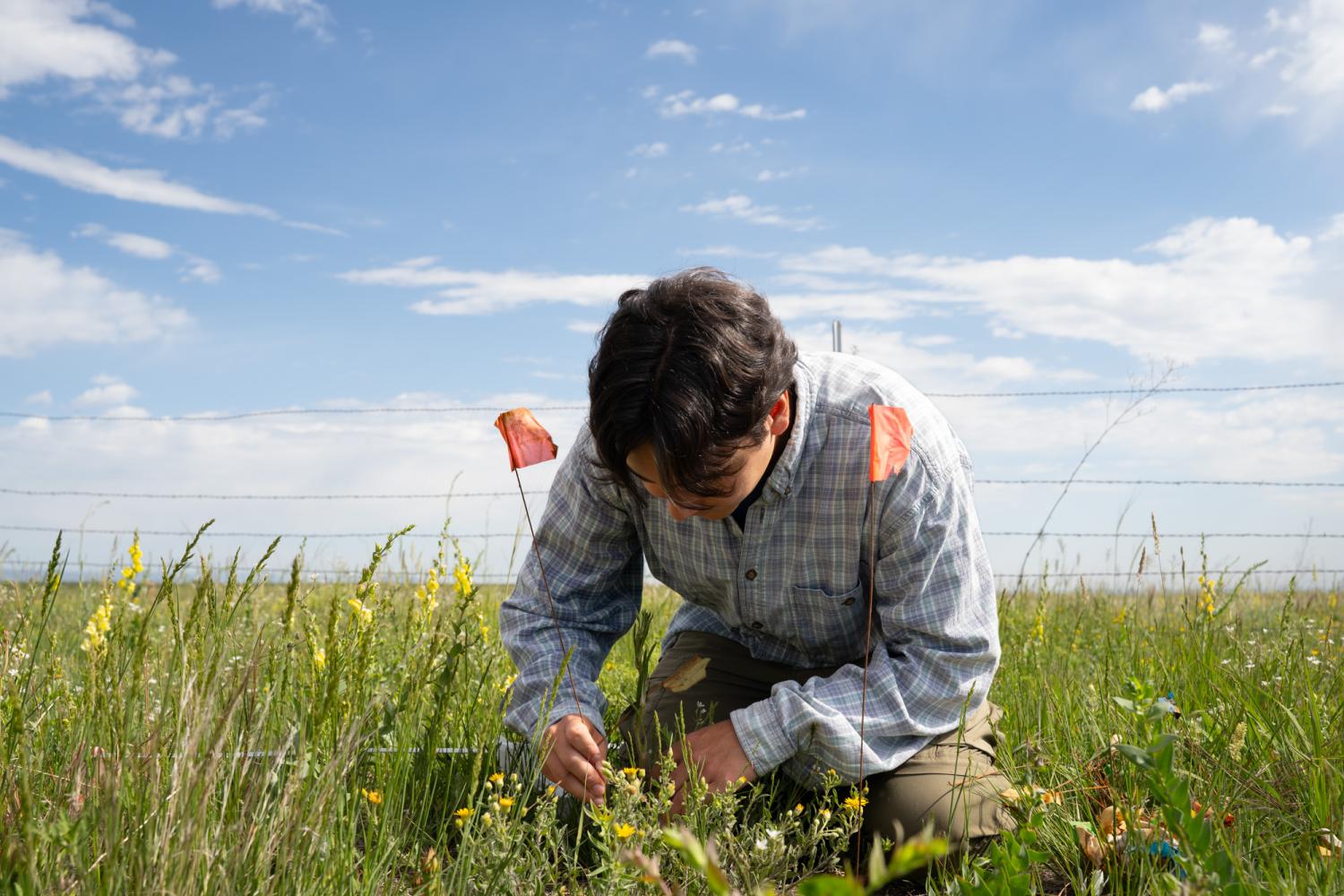Spotlight: Hunter Geist-Sanchez is pioneering restoration methods for Colorado grasslands and reconnecting with his ranching roots

Hunter Geist-Sanchez's summer field crew hikes to a field site near the National Renewable Energy Lab's Flatirons Campus. Left to right: Ava Boettiger, Zade Baldwin, Hunter Geist-Sanchez, Rose Young. (Gabe Allen)
All summer long, INSTAAR masters student Hunter-Geist Sanchez wakes up at dawn to meet a rotating cast of labmates and undergraduate research assistants at a grassy mesa bordering the National Renewable Energy Lab’s Flatirons Campus. The team spends long hours setting up experimental plots, measuring soil moisture and erosion, simulating grazing cattle with a weed whacker and, most of all, mapping plant species.
All the work is in service of the Suding Lab’s grassland diversity and grassland resilience projects. The overarching goal is to cultivate knowledge and management strategies that will help conserve Western grasslands as the climate becomes hotter and drier. This summer, funding from INSTAAR's Summer Scholars Program allowed Geist-Sanchez to expand his undergraduate research team to three members.

Hunter Geist-Sanchez shows undergraduate field technicians a map of a field site near the National Renewable Energy Lab's Flatirons Campus. (Gabe Allen)
Geist-Sanchez is relatively new to this work, but his passion for it is apparent.
"No one cares about grass, but I think grass is pretty great,” he explained during a recent day of field work. “It’s hard to really appreciate the beauty until you spend a lot of time in a certain place. Then you get it.”
Perhaps a piece of Geist-Sanchez’s love for grasslands is hereditary. His family has deep roots in the San Luis Valley, where his grandparents grew up working on local farms and ranches. His great uncle and cousins still own and operate a ranch in the area.
Though Geist-Sanchez has lived his whole life in front range cities, his extended family keeps him connected to Southern Colorado rangelands. Recently, his masters project has been a frequent topic of conversation with still-ranching family members.
“Hopefully this research helps them with restoration on the property,” Geist-Sanchez said. “My great uncle asks me about it all the time.”
For many, 10 or 12-hour stints of data collection in the blazing sun would seem a hefty price to pay for good science. But, Geist-Sanchez seems unfazed by long days in the field. For him, they are a chance to put distractions aside and revel in the details of an ecosystem. It’s a habit that he formed long before he entered academia.
A love of nature
Geist-Sanchez grew up splitting time between parents in Aurora and Fort Collins, with more family spread around Front Range cities. Growing up, his siblings and cousins were mostly captivated by sports and video games — things that Geist-Sanchez also had a passing interest in. But, his true passion was always nature.
“In all my free time, I would go to the library and read Nat Geo books and stuff like that,” he said. “I was really fascinated with wildlife growing up, and no one else was really like that. I knew from pretty early on that I was different.”
Geist Sanchez’s early education in the natural sciences didn’t all come from books. As a kid, he looked forward to family camping trips to Great Sand Dunes National Park, along the Poudre River and to other natural areas across the West. Most of all, he looked forward to spending time with his grandmother on a plot of family land in the San Luis Valley.
“My mom would drop me and my cousins off down there for weeks at a time,” he said. “Those are really fond memories.”
The property was stunning and rugged. To take a bath, Geist-Sanchez remembers filling up buckets from the well and boiling the water on the stove. Days were spent going on hikes and helping his grandmother tend the garden.
For Geist-Sanchez, it was idyllic.
“I just always loved being outdoors,” he said.
After high school, Geist-Sanchez went on to earn a degree in ecosystem science and sustainability from Colorado State University. As an undergrad, he took an unusually active role in several restoration ecology projects. Specifically, he worked with research groups testing new methods for restoring out-of-use agricultural fields and cheatgrass-invaded grasslands.
“After that, I knew I wanted to do more restoration. It’s really difficult work and I was fascinated by how we might be able to improve outcomes,” he said.
After college, one of Geist-Sanchez’s mentors connected him with Katharine Suding, who was looking for a grassland research assistant. After a year in that role, Suding asked Geist-Sanchez to join the lab as a graduate student and take the lead on the lab’s grassland resilience project. Geist-Sanchez jumped at the opportunity — it was a perfect way to sink deeper into his passion for restoring Colorado’s natural systems.
Restoring bare patches

Hunter Geist-Sanchez plants surveyor flags at the Hogan Ranch Property in Boulder. (Gabe Allen)
Restoration ecologists are looking for new methods to combat desertification as the West becomes hotter and drier. In his masters work, Geist-Sanchez has zeroed in on bare-ground expansion — when arid spots lacking vegetation grow over time.
The first step is to figure out how problematic bare patches form and what leads to their growth. To investigate this question, Geist Sanchez is looking at thermal imagery of the landscape, measuring soil characteristics and cataloging the species that grow in and around the sites.
“One of the questions I’m interested in is, ‘What are the mechanisms behind this bare ground spread,” Geist-Sanchez said.
Next comes the question of restoration: how can land managers bring plants back to these sites? To address this, Geist-Sanchez is planting a mix of forb and grass seeds. Importantly, he has balanced the seed mixes to represent plants with specific survival strategies. Plants that arise early in the season may be able to take advantage of spring moisture, and then offer shade later in the summer. Plants with large seeds might be able to survive periods of drought or heat by relying on energy stores.
These hypotheses are based on previous research, but only time will tell their efficacy.
“I guess we’ll have a better idea by the end of the season,” Geist-Sanchez said.
For now, bare patches generally stay small in Boulder grasslands. But, if desertification becomes more extreme in the future, research like Geist-Sanchez’s will become even more important for both natural areas and rangelands.
“We don’t have extreme desertification here yet, which is great,” Geist Sanchez said. “If we ever start to see something like the dust bowl, which stemmed from extreme agriculture and land-use changes, I hope land managers will be able to apply this research. I want to be able to hand this off and expand on it.”
If you have questions about this story, or would like to reach out to INSTAAR for further comment, you can contact Senior Communications Specialist Gabe Allen at gabriel.allen@colorado.edu.

